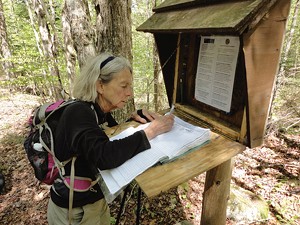Published May 23, 2012 at 7:57 a.m.
For a woman of 77 years, Jean Haigh scoots up mountains with astonishing speed. Leaning into her trekking poles, she takes short, quick steps as she scurries along the trail with the grace and precision of an insect. At stream crossings, she barrels forward, failing to consider which rocks will lead her to the other side — but she always seems to make it across.
“I’ve only been up this trail about 30 times,” Haigh mutters as she briefly loses her way on a rerouted section of a new and growing trail network in the Northeast Kingdom.
We are 10 miles north of Island Pond, in the unorganized township of Avery’s Gore, where the population held to a steady zero as of the last census count. In these woods, long home to saws and skidders, Haigh has labored for more than a decade to open up the working forest to a new crowd: hikers.
Come June, Haigh’s efforts will be rewarded when she is named president of the 10,000-member Green Mountain Club. Founded in 1910 to build the nation’s first long-distance hiking trail, the club is charged with protecting and maintaining all 273 miles of the Long Trail, as well as 175 miles of side trails and a section of the Appalachian Trail stretching from Killington through Norwich.
During her three-year term, Haigh will navigate the club through rugged terrain: It faces internal division over ridge wind power, disappearing funding for conservation initiatives and the growing distractions of a technological age. But those who have worked with Haigh to develop the GMC’s newest trail network say she has what it takes to crest even the steepest slope.
“Everything you can see is part of the Champion Lands,” Haigh says as we pause on a stretch of trail overlooking Black Mountain and Gore Mountain. May is more than halfway over, but spring is still creeping up these hills just south of the Canadian border.
Haigh is referring to the 133,000 acres — or 208 square miles — of prime Essex County timberland put up for sale by the former Champion International paper company in 1997. Since the late 1980s, industrial paper giants such as Great Northern and International Paper had been divesting themselves of the large tracts of northern New England land they had owned, harvested and kept intact for a century.
When Champion put up for sale 300,000 acres of timberland in Vermont, New Hampshire and New York’s Adirondack Park, environmentalists scrambled to ward off development, while the forest-products industry sought to continue working the land, and traditional users fought to preserve access to it.
An eventual compromise engineered by then-governor Howard Dean split Vermont’s Champion Lands among three interests: One-fifth became a state-protected wildlife management area, another fifth was added to the federal Silvio O. Conte National Fish and Wildlife Refuge, and the remainder was sold to Essex Timber Company. Conservation and recreation easements ensured that the 84,000 acres that remained in private hands would not be subdivided and developed — and that hikers, hunters, snowmobilers and others could access it.
Around that time, Haigh was just getting involved with the Green Mountain Club. A native of Rutland, she had grown up hiking and skiing Pico Mountain. With her second husband, she had taken to regularly climbing the Alps. But after they divorced, Haigh, then living in East Craftsbury, was looking for new people with whom to hike.
“I never dreamt I’d become president of the club. Ever, ever, ever, ever!” she says. “I hated clubs!”
Why? “Clubby people do clubby things,” she explains.
In the summer of 2000, Haigh and a small group of GMC members founded a new Northeast Kingdom chapter of the club with the goal of finding a role for the organization in the Champion Lands. Hunters, anglers and snowmobilers had long plied these woods, says Ed O’Leary, director of operations for the Vermont Department of Forests, Parks and Recreation, but “There was not an established hiking trail on the property. It’s a new concept for that area.”
Haigh and her fellow chapter members searched all over the Champion Lands for the right place to build a trail. Eventually, they settled on a stretch of Essex Timber land between two established trails: the Bluff Mountain Community Trail, which links that mountain to Island Pond; and the Gore Mountain Trail, which links Route 114 to an old fire lookout tower. Between the two lies a long ridgeline passing over Middle Mountain and overlooking the aptly named Unknown Pond.
“It started out with a hand-sketched line on a topo map, and it sort of sat out there for a long time,” says Luke O’Brien, who, as trail director of the NorthWoods Stewardship Center in East Charleston, had pondered such a network for years. “We kind of pulled this out of the filing cabinet and said, ‘Here are two existing trails separated by around 12 miles.’”
It took nearly a decade for all the entities involved to sign off on the trail, for Haigh and O’Brien to settle on a route, and for the GMC to break ground. Through it all, O’Brien says, Haigh was “the emotional leader of this whole project.”
“Every volunteer effort needs somebody there cracking the whip and saying, ‘Come on, people,’” O’Leary says. “She’s a pit bull. She’ll get in there and push — in a nice way, but she’s influential.”
As a resource supervisor for Plum Creek Timber Company, which bought the land owned by Essex Timber in 2008, Chris Fife has worked closely with Haigh to ensure that the new trail network does not interfere with the company’s logging operations.
“Jean has been the one that’s been pushing this forward the entire time and stuck with it, doggedly kept with it,” he says. “She’s just very committed to this project, very excited about it. She’s obviously been thrilled to see the groundbreaking on it.”
That groundbreaking finally took place last July, when a crew of eight 16-to-20-year-olds from the NorthWoods Conservation Corps began work on the first mile of new trail leading from the existing Gore Mountain Trail to a massive glacial erratic known as Split Rock.
Standing below a temporary wooden sign marked “Gore Junction,” where the new Middle Mountain Trail originates, Haigh says contentedly, “Not many people have seen the start of the trail. So welcome!”
It’s the first time Haigh has set foot on the trail since winter, and as we hike she inspects troublesome sections to see how they weathered the snowmelt. On one flooded stretch of trail, she shouts, “Rats!”
Barely five feet tall and weighing 40 pounds less than Nahani — her 10-year-old wolf-malamute hybrid — Haigh takes two steps for every one step an average-size hiker might. A series of back and spine ailments stemming from a 1964 car accident have left her with a noticeable stoop, along with numbness and pain in her back and leg. “But I manage,” she says.
As we near Split Rock, Haigh’s lack of sensation in her leg causes her to trip on an errant root, and she sprawls headfirst on the ground. Barely skipping a beat, she hops back to her feet, refusing to take a break.
Friends and colleagues cite Haigh’s perseverance and drive when they assess how she’ll fare as president of the statewide hiking organization.
“She is small in size, but large in enthusiasm and determination,” says Tom Candon, a GMC member from Shelburne who hiked with Haigh two years ago during an end-to-end relay of the Long Trail to mark the club’s 100-year anniversary. “I’ll tell you, it was a job keeping up with her. She set a good pace for both old and young on that hike. She loves it, and you can feel that when you’re with her.”
Outgoing GMC president Marge Fish says Haigh’s “energy and her ability to work with many kinds of people” will serve her well during her three-year term overseeing the club.
“I should have so much energy in 10 years!” Fish says. “She’s truly one of my role models. She’s 10 years older than me, and anytime I think I should slow down, I look at Jean and say, ‘Not yet.’”
GMC executive director Will Wiquist, who joins us for the hike, says, “The only thing Jean doesn’t do well is retire.”
Indeed, Haigh plans to continue training Northeast Kingdom teachers as a consultant for the state Department of Education even as she takes the reins of the GMC. A former special education director in several Vermont school districts, Haigh was also a professor of special education instruction at Johnson State College for nearly a decade.
“It’s a lot of driving,” she says, “but it’s great.”
At Split Rock, we reach the end of the trail — for now. Standing some 15 feet high, the two separated rock masses are covered with moss and pine and ancient stumps. Atop them, one can take in a sweeping view of mountains once accessible only to the intrepid explorer with map and compass.
Here on Split Rock, we are still just two-and-a-half miles from Route 114. The rest of the trail, which will wind its way to the summit of Middle Mountain before heading 12 miles south to the Bluff Mountain Trail, may take another decade to complete. The NorthWoods Conservation Corps plans to build another mile and a half of trail this summer, O’Brien says, but in the present nonprofit funding environment, progress will likely be slow and steady.
“There’s a lot to building a trail,” Haigh says.
As we turn around and descend Middle Mountain toward Gore Junction, Haigh says the experience of mapping a public trail through private land has given her a new appreciation for the forest-products industry. Like many environmentalists, Haigh had long harbored suspicions about logging companies, but her collaboration with Plum Creek — the largest private landowner in the United States and an occasional subject of criticism for developing large tracts of wilderness — has largely been positive.
“The more I work with foresters on the trail, it’s really made me more objective,” she says.
Fife says that, while Plum Creek will continue to harvest timber near the trail, he is hopeful hikers will understand the nature of the working forest: that an occasional skidder may cross the trail and an occasional clear-cut may be necessary.
“We are all on the same page and understand the potential for conflict, just from hikers not used to seeing active forest operations, so we try to do everything we can to educate them,” Fife says.
That the Champion Lands have a history of timber production is abundantly clear to any who walk these woods. This is hardly untouched forest. The trail crosses one clear-cut and many more disused logging roads. Young stands of trees suggest a history in which humans have taken much from these woods.
Fife says Haigh understands and appreciates that.
“I guess I would credit that to her being tied in to the Northeast Kingdom of Vermont. She understands the history of it, the economy that’s tied to the working forest, the access that’s provided by working forests with road networks and allowing people to get into some of these great spots to hike,” Fife says.
Haigh says she is motivated in her trail work by “an appreciation for the forest, an appreciation for the land and the wildness of the land.”
She hopes to make that land open and available to all — in the Northeast Kingdom and throughout the GMC’s vast trail network.
“When you go out on that trail, you’re in the land of the moose, the bear, the fisher,” she says. “This is where they can connect across the forest. We’re trying to leave a very small footprint on this, but we’re trying to expose people to the importance of wild lands.”
More By This Author
Speaking of...
-

Regulators Are Poised to Let Vermont Gas Buy Methane From a Distant Landfill
Oct 21, 2022 -

Video: Gail and George Africa of Vermont Flower Farm Plan to Retire
Sep 8, 2022 -

Under New Ownership, Turtle Fur Plans to Expand Its Offerings
Aug 1, 2022 -

Video: Talking Trees With Burlington Arborists
May 5, 2022 -

Increasing Downpours Impede Efforts to Improve Lake Champlain's Water Quality
Aug 18, 2021 - More »
Comments
Comments are closed.
From 2014-2020, Seven Days allowed readers to comment on all stories posted on our website. While we've appreciated the suggestions and insights, right now Seven Days is prioritizing our core mission — producing high-quality, responsible local journalism — over moderating online debates between readers.
To criticize, correct or praise our reporting, please send us a letter to the editor or send us a tip. We’ll check it out and report the results.
Online comments may return when we have better tech tools for managing them. Thanks for reading.















































